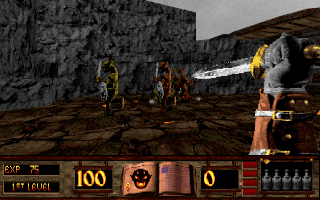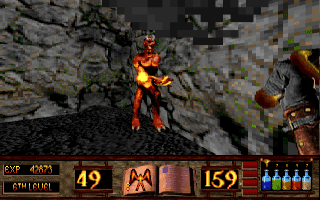8.2 /10 1 Votes8.2
Writer(s) Mike Pitts Initial release date 1995 Publishers IntraCorp, U.S. Gold | 4.1/5 My Abandonware Composer(s) Joe Abbati Platform DOS | |||||||||||||||||||||||||||||||||
 | ||||||||||||||||||||||||||||||||||
Producer(s) James M. WheelerAmy Smith Boyland Programmer(s) Rafael PaizLes BirdJoe Abbati Artist(s) Scott NixonErnesto Roque Mode(s) Single player, multiplayer Genres First-person shooter, Action role-playing game Similar Capstone Software games, First-person shooter games | ||||||||||||||||||||||||||||||||||
Dos game witchaven
Witchaven is a fantasy first-person shooter video game with action role-playing game elements, developed by Capstone Software and published by Intracorp Entertainment in 1995. Its sword and sorcery style story tasks the knight Grondoval with a quest to seek out and kill an evil witch in her titular fortress. The game was based on the Build engine and received mixed reviews. It was followed by the sequel titled Witchaven II: Blood Vengeance in 1996.
Contents
- Dos game witchaven
- One of the coolest games ever witchaven
- Gameplay
- Plot
- Development
- Reception
- Legacy
- References

One of the coolest games ever witchaven
Gameplay

Although the game is considered a first-person shooter (FPS), the game has several role-playing game (RPG) elements, including character progression by acquiring experience points (gained by defeating enemies and finding gold) and level advancement with increasing number of hit points, damage modifiers and weapons proficiency, and access to more powerful spells at higher levels. The game also has a focus on close-quarters combat, unlike the standard run-and-gun gameplay of most first-person shooters at the time. Other than that, the game is similar to many typical FPS games of its era in that the player needs to kill everything that moves in his path while looking for color-coded keys to open closed doors, and eventually to find an exit that would lead to the next level. There are also options to adjust the game's difficulty and gore levels.

There are ten weapons in Witchaven, each with a different attack range and other characteristics. Among them are bare fists, a dagger, a short sword, a morning star, a broadsword, a battle axe, a bow and arrows, throwing axes, a pike axe, a two-handed longsword and a halberd. One of the game's more innovative features is that weapons are not infinitely durable. With the exceptions of the fists, weapons will break down with repeated use and replacements must be found in order to continue fighting. The player can also find different types of armor (only one of which may be worn at a time) at the time, each with various values of their starting armor points, a number of armor points that are subtracted with each hit, and a chance of deflecting the attack completely. There is also a shield that acts as a weak armor but can also be used to attack, while helmets add armor points and also double the damage the player inflicts for a while.
Fighting consists not only of hand-to-hand combat but also of the use of magic. There are several types of the scroll-based spells which can be cast by the player, such as the Fireball, Fly, Freeze, Scare, Unlock, and Nuke invocations. The player can drink various potions for restoring health, curing poison status, or gaining supernatural strength (increased damage), invincibility or invisibility for a half minute. Other items are the ankh symbol that gives the player the maximum number of 250 health points and a crystal staff that also gives a maximum number of 300 armor points, magic amulets activating invisibility or scare magic for one minute, horns that enable the player to steal the enemies' health points, and various magic rings providing different types of protection such as fire resistance, and scepters enabling to walk on either water or lava.
There is a plethora of enemies the player must contend with, including goblins, ogres, imps, skeletons, willow wisps and fire drakes. Some of them are prone to fighting against the other types of enemies (for instance, differently-colored rival goblin tribes will attack each other if put in close proximity). Treasure chests can contain wealth or traps. Illwhyrin the witch is the only boss of the game but she appears repeatedly through the game, teleporting away when losing, until the final battle at the 25th level where she can summon monsters; the game ends with her death.
The game also offers a LAN-based deathmatch-style multiplayer mode with 10 additional multiplayer-only maps. It was made available for up to 16 players, as the first time a multiplayer 3D action game to featured as many players simultaneously.
Plot
In Witchaven, the player is cast in the role of Grondoval, a knight in service of his homeland Stazhia, been chosen by his master, Lord Verkapheron, for a mission to rid the world of the threat posed by the evil Illwhyrin. In her lair, known as the realm of Witchaven and hidden in a massive subterranean maze under the forbidding Isle of Char, Illwhyrin performs sinister rituals seeking to lift a dimensional barrier, known as the Veil, that separates the game's universe from chaotic Nether Reaches. If she succeeds, she might access unlimited dark powers to draw upon and gather a vast horde of demonic minions to use as armies for conquest. Grondoval arrives at Char by boat, armed only with a dagger. He needs to fight his way through the hordes of monsters dwelling in a labyrinth of dark caves and dungeons so he can reach Illwhyrin's inner sanctum in time and put an end to her before it is too late.
Development
Along with William Shatner's TekWar, also made by Capstone Software in 1995, Witchaven was one of the first games released to use an early version of the Build engine, which did not yet feature sloped ceilings and floor that 3D Realms added later in 1995. Generic enemies are actually clay-made models, first photographed at every angle, then turned into computer sprites. Illwhyrin was played by the game's product manager Judy Melby. In-game weapon models were also created by using digitization, based on the weapons provided by the BlackSword Armoury Inc. The game's intro sequence was created by Shadows in Darkness (then known as Animation Factory) as their first work. Witchaven Official Strategy Guide by Brady Games features original artwork and behind-the-scenes with the game's creators.
The concept "violent, first-person action game set in a fantasy universe ruled by a coven of evil witches who must be eradicated from their lairs" was created after the team attended Gen Con 1993. The development began in 1994, following the completion of Operation Body Count. At first, the protagonist character was said to be split into two classes for the player to choose: spellcaster or warrior, and an early design called for the player to choose a class and a gender (these features were later seemingly abandoned in favor of a predefined male hero character capable of using both weapons and spells). An early version of the game's story, which was featured in early promotional materials, involved three witches "older than time itself".
The game's three-level demo version included features that differed from the full version. The demo version only included five weapons to wield and only six spells. Instead of a potion that cured poison, the demo version used an armor potion that increased armor value. Similarly, the fire resistance potion was replaced with a fire walk potion. The demo version's story told of a group of "Death Magic" practising witches and their plan to activate the volcano of Char that has been dormant for two centuries, causing it to erupt and threaten the surrounding areas, and the yet-unnamed "brave Stazhian" hero's quest was to break this curse by vanquishing them. Although the story changed before the game's release, the sequel still mentions an eruption of the Char's volcano and speaks about the destruction of plural "witches in their wretched lair" while telling the game's backstory; similarly, the official website includes the phrase the "Witches of Char" in its description of the game.
Reception
Witchaven was met with a generally mixed or average critical reception. PC Zone gave it a score of 88/100 and recommended it: "Witchaven is packed with lots of spells and potions to play with, the usual network/modem options, triggers and traps, impressive graphical effects - and if you're looking for gore you've found it. Sick, twisted and violent - we like it." Lim Choon Wee of New Straits Times wrote "I love Witchaven," especially praising the game's "bewitching" graphics. Polish magazine Gambler gave it an overall review score of 90%, and German magazine PowerPlay gave it two scores of 71% each for both single-player and multiplayer modes. On the other hand, Petra Schlunk of Computer Gaming World described the game "less than spellbounding" despite the "eye-popping gore and a few cosmetic RPG elements" and very disappointing for its lack of real gameplay immersion, concluding it to be "just another" Doom clone. According to Jim Varner of GameSpot, "Witchaven is certainly not a bad game, but it's not that great either," as "in-your-face combat is novel at first, but after a few hours of play, you'll be praying for a BFG-9000."
Legacy
A direct sequel titled Witchaven II: Blood Vengeance was released in 1996. In this game, Grondoval's new enemy is the slain witch's vindictive sister. The gameplay of Witchaven II is based on its predecessor, the only differences being in some additional weapon selection and enemy variance. A third game in the series was briefly considered, possibly to keep with the original game's ending text premise of Grondaval eventually becoming a king, but Intracorp bankrupted and Capstone was shut down before any work on it started (the game was scheduled to be made after Corridor 8, which was never finished). Around 2006 the former Capstone programmer Les Bird released the source code of Witchaven and Witchaven II. In addition, a black metal band Witchaven took its name from the series, and Techland's upcoming video game Hellraid was described as a spiritual successor to Witchaven and Hexen.
